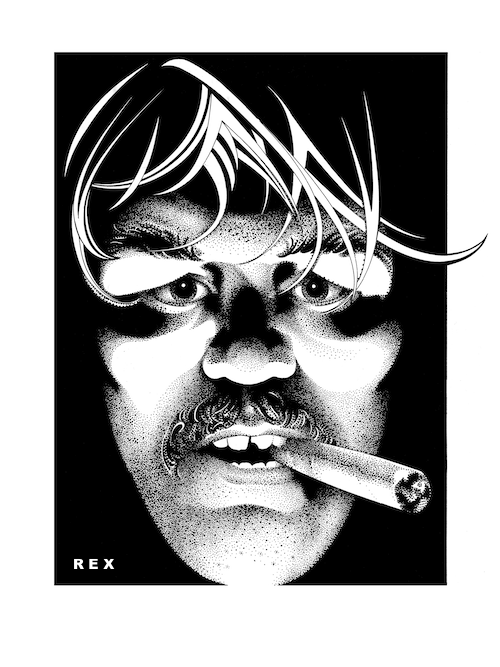Reclusive artist created images of beauty, humor
If it weren’t for Bob Mizer, Harry Bush’s immense talent – and the bitterness and anger boiling underneath the hand that created stunning images of...
3 min read
Bob Mizer Foundation : Dec 1, 2015 2:17:00 PM

While his mainstream counterparts in the art world were being trained in some of the world’s finest art institutes and honing their craft in sterile classrooms among the rigidity of academia, the erotic artist known as Rex received his education in the streets, in public toilets, in bars. These places offered a home to a man who, from an early age, was part of a community whose members could only truly be themselves in the embrace of the shadows.
“Basically, erotic artists were ‘self-taught,’ as no one ‘taught’ how to draw dirty pictures, so they mostly hooked up with others with similar interests,” Rex says. “Consequently, all the erotica from my youth that was available were the crude drawings of amateurs you found on bathroom walls. Sex was the object of the exercise, not drafting skills. Conversely, no one in the art world then considered sexual drawings ‘art,’ or even acknowledged their existence in print. Those were pornographic dirty pictures, plain and simple; nothing else.
 Rex’s black-and-white illustrations, carefully crafted with pen and ink, depict a sado-masochistic world inhabited by--as Drummer editor Jack Fritscher once wrote--“filthy construction workers, greasy gas jockeys, muscled bikers, beautiful young homeless men, pissing ex-cons and armpit-sweaty studs needing head … unshaved ‘lone wolves’ in jockstraps, leather, boots and torn tank tops.”
Rex’s black-and-white illustrations, carefully crafted with pen and ink, depict a sado-masochistic world inhabited by--as Drummer editor Jack Fritscher once wrote--“filthy construction workers, greasy gas jockeys, muscled bikers, beautiful young homeless men, pissing ex-cons and armpit-sweaty studs needing head … unshaved ‘lone wolves’ in jockstraps, leather, boots and torn tank tops.”
According to at least one British artist, little is known about Rex’s origins, save the fact that he was born in the early 1940s. His exact date of birth and real name are lost to time, only adding to his reputation as a “shadowy figure” in the art world.
What we do know is that New York called to Rex as a teenager in the late 1950s, having lived most of his childhood on a farm in New England as a ward of the state, according to a recent profile of the artist. Rex ran away to New York, beginning his long, storied career as an apprentice to a fashion designer. Rex continued to work as a fashion illustrator well into the 1960s, dividing his time between London, Paris and New York’s East Village.
Rex disappeared from the art scene only to re-emerge in the 1970s, when the leather scene in certain areas of New York introduced gay men to a more raw, hyper-masculine lifestyle. Although the artist brought this new world to life in his drawings, he recognized the need for anonymity and, like Bob Mizer and so many other artists who trumpeted the pure beauty of the male form, fully realized the dangers his profession posed to those who did not understand and appreciate his vision.
“I signed myself as ‘REX’ because it was non-specific and untraceable in those days by the cops,” he explains.
Word about the quality and themes in Rex’s drawings quickly spread throughout New York’s gay community, and soon across the country. Several gay bars and leather shops commissioned work from Rex, his most notable at this time being work done for The Mineshaft, arguably New York’s most well-known gay sex club of the era.
“His illustrations reflected the extreme sexual activities of the newly empowered pre-AIDS gay community that celebrated sex blatantly and without apology,” notes one profile of Rex.
 After his Mineshaft Posters became popular, more commissions came pouring in; from Drummer magazine to The TRADING Post, considered to be the first gay department store. By the mid-1970s, Rex’s art was compiled in three self-published 36-page portfolios, titled “Mannespielen,” with volume I being published in 1975 and volume II being published the following year. The popularity of these volumes, whose contents were compared to the early 1950s work of illustrator George Quaintance, led to the later publication of 12 printed, unbound portfolios sold thru mail-order. The unbound editions, for the first time allowed lovers of Rex’s work to frame and display their favorite pieces. These self-published works were followed by a hardcover book of 50 drawings, “Rexwerk,” published in 1986 in Paris.
After his Mineshaft Posters became popular, more commissions came pouring in; from Drummer magazine to The TRADING Post, considered to be the first gay department store. By the mid-1970s, Rex’s art was compiled in three self-published 36-page portfolios, titled “Mannespielen,” with volume I being published in 1975 and volume II being published the following year. The popularity of these volumes, whose contents were compared to the early 1950s work of illustrator George Quaintance, led to the later publication of 12 printed, unbound portfolios sold thru mail-order. The unbound editions, for the first time allowed lovers of Rex’s work to frame and display their favorite pieces. These self-published works were followed by a hardcover book of 50 drawings, “Rexwerk,” published in 1986 in Paris.
For every fan of Rex’s pioneering works, however, there were equal numbers of detractors, naysayers and critics. Some of the themes in Rex’s works proved taboo for some members of the gay and art community, the art community. Nevertheless, San Francisco's elite had once included him in an exhibition as one of the city’s “100 Most Influential Artists.” The inclusion of controversial subject matter in some of his illustrations led to censorship of his work by galleries in the U.S. although Rex admits that the European art world were more welcoming and accepting of his more controversial work.
To Rex, some of the themes in his work speak to the darkest, most private desires of those who lay eyes on his drawings.
“It portrays images of male sexuality that many people are afraid to acknowledge in public, or to their peers,” Rex says. “To admit ‘liking’ my work or displaying it, by extension implies things about ‘yourself’ – your secret desires, perhaps – that people naturally want hidden. Our real sexual desires are privately held concepts, to be confronted only when we are alone and have taken a hit of poppers. You don’t discuss these subjects with anyone but your own libido.”
Though Rex, who now divides his time between Amsterdam and San Francisco, says that commissioned illustrations constitute a majority of his workload, his work was recently featured in a gallery show in Amsterdam.
At the heart of Rex’s work – and that of any artist – is an ardent support of freedom of expression. When that freedom is challenged and an artist’s work is censored, Rex explains, the artist’s truth hasn’t just been radically diluted – it’s been erased.
“Freedom of expression lies at the very core of any creative activity,” Rex says. “When it is censored, the ‘truth’ is being cut out of your vision, which freedom of expression is supposed to guarantee. It is not for others to decide what we should think, see or show.”
For more information, please visit www.rexwerk.com.

If it weren’t for Bob Mizer, Harry Bush’s immense talent – and the bitterness and anger boiling underneath the hand that created stunning images of...

In the same way that Bob Mizer was known for his use of props and costumes in his still images and films, so too are French duo Pierre Commoy and...

The latest professional endeavor by Lucas Murnaghan, an artist profiled in Physique Pictorial Vol. 44 with his images of models immersed in...

Dive into the mesmerizing fusion of The Go-Go's punk energy and Bob Mizer's vintage underground visuals that made Coachella 2025 unforgettable.